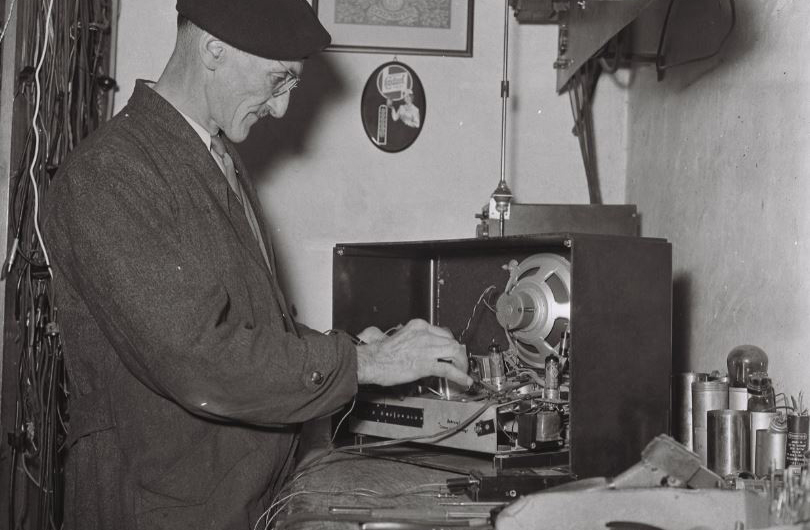Rebecca Mossop
Rebecca is a PhD Candidate working on the REPAIR project
MORE ABOUT THIS AUTHOR
On the second day, five papers were presented in three panels. In the first panel entitled “Visual Inventory of Repair”, ANAÏS BLOCH (HEAD, Geneva) started off by presenting “Mobile Repair Cultures: from Informal Repair to Silent Innovation, the Smartphone Case” and spoke about her work on the visual representation of repair cultures in mobile phone repair shops in Switzerland. This allowed an artistic view of the connection between body and (repair) technology. The lecture showed that endogenous, practised repair patterns are a kind of standardisation of repairs, an extension of repair equipment by the body, and at the same time very unique practices that arise from the relationship between technology and people.
On the topic “Maintaining Infrastructures”, LAURA MENEGHELLO (Siegen University), MARTIN MEISKE (Ludwig-Maximilians-University Munich) and AMANDA MCMILLAN LEQUIEU (Drexel University) provided crucial insights into modern and past infrastructures and their interpretations.
Laura Meneghello spoke in her presentation “Between Old and New: Modernizing, Maintaining and Repairing Pneumatic Tube Systems” about the pneumatic mail systems that were introduced from the 19th century onwards in cities and companies, explaining that they were an important, though partially forgotten, element of the communications and transportation infrastructure at the time. Municipal networks were used to send telegrams, letters, documents and small packages through pneumatic tube systems. She showed that smaller pneumatic tube networks were used in factories, hospitals, libraries, offices and administrative buildings to move documents, mail and small items through buildings. Maintaining those networks was a daily task, undertaken in part by specialised personnel and in part by the users themselves, who had to both prevent and correct problems in moving the capsules through the tubes. Secretaries were involved in the maintenance of pneumatic tube networks in offices, as were workers in factories and nurses in hospitals. This maintenance by professionals and non-professional users indicates that infrastructures are themselves a product of constant labour and repair work, in turn creating new work themselves, and that they both shape and are shaped by people.
In his presentation “Cultures and Costs of Maintenance. The Rise of Creosote and its Precarious Legacy”, Martin Meiske examined the impact of creosote and its use as a treatment for wooden railway sleepers, which had to be replaced in regular maintenance cycles. Creosote was used in the railway infrastructure to extend the lifespan of sleepers, so Meiske looked at the long-term effects of railway maintenance using this toxic chemical. While some of the occupational health effects of creosote impregnation did not become apparent until workers had been handling the product for several years, the environmental impacts were severe and unequivocal, especially since creosote was classified as hazardous waste. Nevertheless, the chemical was an inherent part of the infrastructure. As a result of the tightening of environmental regulations in the 1980s, cadastres of contaminated sites were established in several countries. The narrative of creosote thus promised to finally shed light on topics such as recycling and upcycling, and thus on the interaction of people and infrastructure, especially when it comes to problematic substances that are only classified as such over time.
Amanda McMillan Lequieu’s presentation, “Imagining the Unmaintained Object: Industrial Transportation Infrastructure Decline as Narrative Symbol in the American Rust Belt”, explored the narratives of transportation infrastructure decline that enabled a redefinition of deindustrialisation not as a one-time event but as a protracted episode of disinvestment involving specific political and economic actors. She presented the results of nearly 100 interviews and ethnographic and archival research she conducted between 2015 and 2018. She investigated the nodes of a now defunct commodity chain of iron and steel that stretched from a former iron mining district in Wisconsin to a steel mill district in Chicago. The interconnected nature of infrastructure and the fragile landscapes of deindustrialisation drew attention to the fact that material culture is much more than symbolic. These infrastructure problems, as McMillan showed, have material consequences for future development, and they can only be solved by another round of economic and political reinvestment from above.
In the last panel, “Maintaining Everyday Repair Opportunities”, THOMAS HOPPENHEIT and STEFAN KREBS (University of Luxembourg) presented “The Decline of Repair Businesses? Luxembourg’s Repair Sector, 1971-1985”. In their presentation, they showcased the perceived decline of repair services in Luxembourg as a case study for Western consumer societies in the short 20th century. Small repair shops are believed to have long been on the verge of disappearance. But although the 1970s and 1980s are often described as a turning point in the history of repair, Hoppenheit and Krebs stated that repair statistics for Luxembourg do not confirm a decline in repair during this time span. The assumption that repair services should have gradually disappeared and become obsolete during this period because of the availability of cheap consumer goods and the new throwaway culture could not be confirmed. Although official statistics showed a general stagnation and restructuring of the Luxembourg repair sector, the statistical data covered only a fraction of repairers. If one takes into account the statistical exclusion of some repair shops in the 1970s, it can be assumed that repair even gained in economic importance in the 1980s. These data allowed for some interesting observations that argue against the notion of repair as a dying trade.
All in all, the diversity and breadth of the research field was evident in these short two days. The importance of the various histories of maintenance and repair in socio-technical terms was clearly demonstrated. This relatively young field still holds many unexplored corners, black boxes and linguistic encodings. From challenging the history of technology’s understanding of its own scope to learning about very different forms of knowledge transfer (from highly formalised to experimental) and the various expected and surprising human actors that make up networks of maintenance and repair, the workshop offered fertile ground for discussions, while also inspiring some ideas for future research projects.
Follow this link to discover the first day of the workshop.